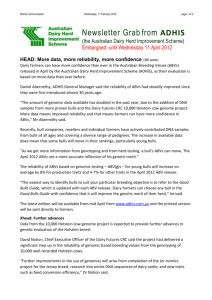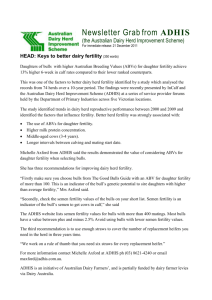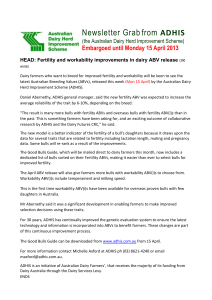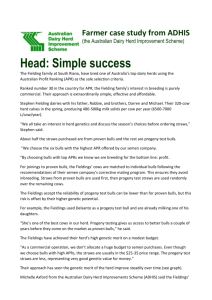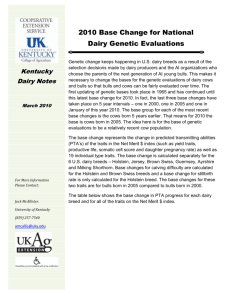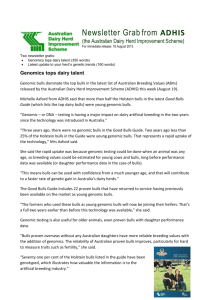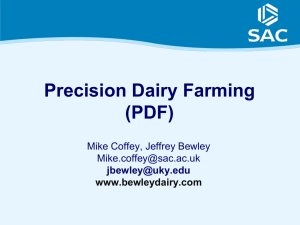Better genes, more milk, regardless of the feeding system
advertisement
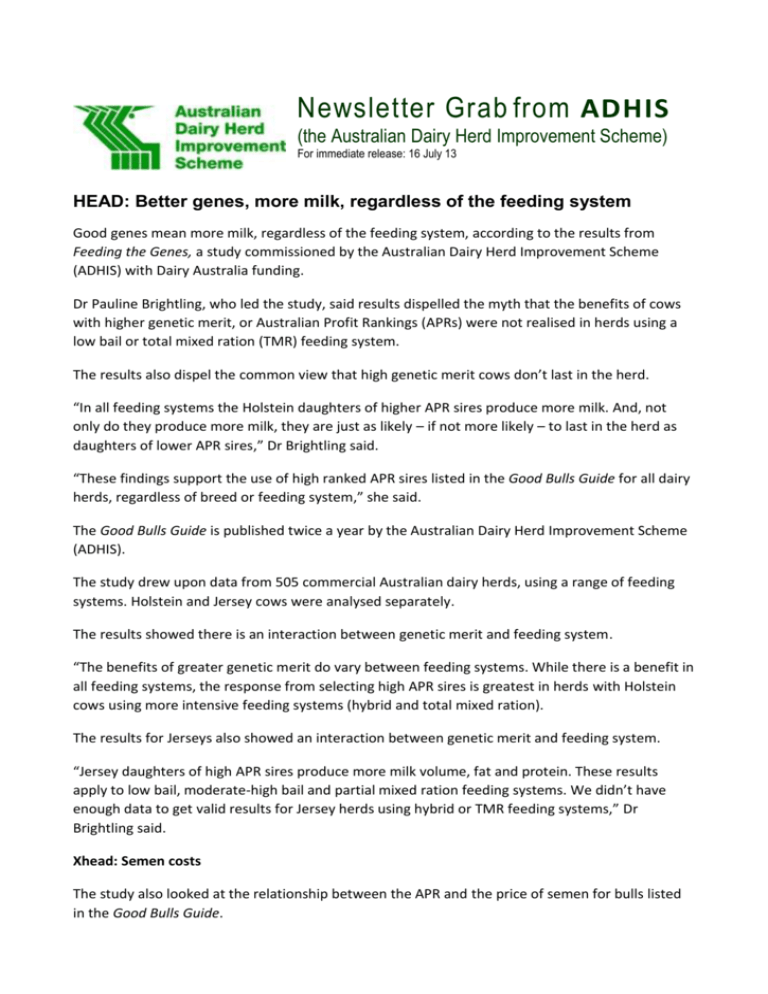
Newsletter Grab from ADHIS (the Australian Dairy Herd Improvement Scheme) For immediate release: 16 July 13 HEAD: Better genes, more milk, regardless of the feeding system Good genes mean more milk, regardless of the feeding system, according to the results from Feeding the Genes, a study commissioned by the Australian Dairy Herd Improvement Scheme (ADHIS) with Dairy Australia funding. Dr Pauline Brightling, who led the study, said results dispelled the myth that the benefits of cows with higher genetic merit, or Australian Profit Rankings (APRs) were not realised in herds using a low bail or total mixed ration (TMR) feeding system. The results also dispel the common view that high genetic merit cows don’t last in the herd. “In all feeding systems the Holstein daughters of higher APR sires produce more milk. And, not only do they produce more milk, they are just as likely – if not more likely – to last in the herd as daughters of lower APR sires,” Dr Brightling said. “These findings support the use of high ranked APR sires listed in the Good Bulls Guide for all dairy herds, regardless of breed or feeding system,” she said. The Good Bulls Guide is published twice a year by the Australian Dairy Herd Improvement Scheme (ADHIS). The study drew upon data from 505 commercial Australian dairy herds, using a range of feeding systems. Holstein and Jersey cows were analysed separately. The results showed there is an interaction between genetic merit and feeding system. “The benefits of greater genetic merit do vary between feeding systems. While there is a benefit in all feeding systems, the response from selecting high APR sires is greatest in herds with Holstein cows using more intensive feeding systems (hybrid and total mixed ration). The results for Jerseys also showed an interaction between genetic merit and feeding system. “Jersey daughters of high APR sires produce more milk volume, fat and protein. These results apply to low bail, moderate-high bail and partial mixed ration feeding systems. We didn’t have enough data to get valid results for Jersey herds using hybrid or TMR feeding systems,” Dr Brightling said. Xhead: Semen costs The study also looked at the relationship between the APR and the price of semen for bulls listed in the Good Bulls Guide. The semen of the Holstein top 50 APR bulls does not necessarily cost more than that of other bulls. “Semen price is not a barrier to using high APR bulls. The catalogue price for straws from the top 50 APR bulls in April 2013 ranged from $14 to $90 and averaged $27.17,” she said Regardless of feeding system, herd managers should select high APR sires whose Australian Breeding Values are aligned with the breeding objectives for their herd. These bulls are listed in the Good Bulls Guide. The Good Bulls Guide is published twice a year by ADHIS. The Feeding the Genes ‘short report’ can be downloaded from http://www.adhis.com.au/ ADHIS is an initiative of Australian Dairy Farmers’, that receives the majority of its funding from Dairy Australia through the Dairy Services Levy. ENDS Image: Click here to have a high res images sent to you by automatic email adhis-feedgenes@monkscom.com.au Caption: In all feeding systems, the Holstein daughters of high genetic merit bulls produce more milk and last as long or longer in the herd than the daughters of low genetic merit bulls. Report cover: Cover ADHIS FTG Short Report-v5.pdf Media contact: This media release has been issued by Monks Communication on behalf of ADHIS. Contact Monks Communication for inquiries about photos and interviews or to have your contact details removed or updated on our distribution list: Lee-Ann Monks ph (07) 5450 0946 mob 0419 349 244 email: media_releases@monkscom.com.au Note: we are in a poor mobile reception area – try the landline first. About ADHIS (background information for media) The Australian Dairy Herd Improvement Scheme (ADHIS) is an initiative of the Australian Dairy Farmers (ADF) to assist genetic improvement in the dairy industry. ADHIS maintains a national database of performance and pedigree details for individual dairy animals. The data base is used to generate Australian Breeding Values (ABVs) which indicate a cow or bull’s potential genetic merit (ie it’s breeding value to a dairy herd). Genetic gain has increased significantly since 1983 when farmers began utilising ABVs. Each year the genetic merit of artificially bred cows is increasing, worth about $9.40/cow/yr in extra profit. The value of these gains to the industry is approximately $20 million per year. ADHIS is partly funded by farmer levies through Dairy Australia. ABVs and ABV(g)s are produced for a variety of traits including milk yield and composition, workability and survival as well as profitability. Updated ABVs are released twice a year (April and August) for use by dairy farmers and artificial breeding companies. ADHIS also releases ABV(i)s for foreign bulls three times per year (April, August and December). ADHIS is an initiative of Australian Dairy Farmers’, that receives the majority of its funding from Dairy Australia through the Dairy Services levy.
